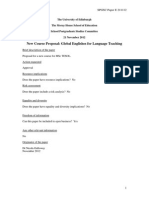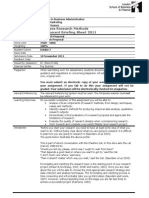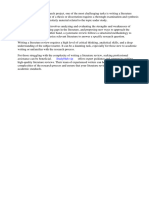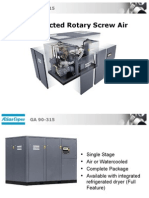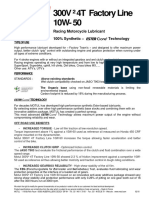How To Write A Research Proposal
Uploaded by
Kelvin YongHow To Write A Research Proposal
Uploaded by
Kelvin YongHow to write a research proposal?
The research proposal is an outline of your research project that you will carry out during your PhD. Remember that the research proposal is the key element of your application by which you present your innovative research project. It is important to convince your reader of the potential impact of your proposed research. What is more, we are looking for projects that further the understanding of our five focus areas. Therefore, you should choose one specific focus area and develop a relevant research project proposal. The proposal should not be longer than 10 pages. It is not relevant to achieve this number of pages, but to provide a high quality project proposal. The following guideline shall support you in writing a sound research proposal. Think of an informative but catchy title of your research project. An effective title not only attracts the reader's interest, but also predisposes him/her favourably towards the proposal. The abstract is a brief summary of approximately 300 words. It should include the research question, the rationale for the study, the hypothesis , the method and the main findings. Descriptions of the method may include the design, procedures, the sample and any instruments that will be used. You might als include a small number of keywords. The main purpose of the introduction is to provide the necessary background or context for your research problem. It typically begins with a general statement of the problem area, with a focus on a specific research problem, to be followed by the rational or justification for the proposed study. The introduction generally covers the following elements:
State the research problem, which is often referred to as the purpose of the study. Provide the context and set the stage for your research question in such a way as to show its necessity and importance. Present the rationale of your proposed study and clearly indicate why it is worth doing. Briefly describe the major issues to be addressed by your research. State your hypothesis or theory. Set the delimitation or boundaries of your proposed research in order to provide a clear focus. Furthermore, you define a concrete problem which you want to investigate. By defining your research problem you show that you seek to fill a gap in knowledge that you have found. Narrowing down the research problem includes the following questions:
Why do we care about the problem? What practical, scientific, theoretical or artistic gap is your research filling? Then summarise the state of the art of research in your field and its direct relationship to this project.
What do we already know about the problem? What research has been done in this field? This section includes a literature review which serves several important functions:
Gives credits to those who have laid the groundwork for your research. Demonstrates your knowledge of the research problem. Demonstrates your understanding of the theoretical and research issues related to your research question. Shows your ability to critically evaluate relevant literature information. Indicates your ability to integrate and synthesize the existing literature. Provides new theoretical insights or develops a new model as the conceptual framework for your research. Based on your research problem and the state of the art you define your objectives andtheoretical approach of the proposed research by answering the following questions:
What is the aim/interest of your project? Why is your research question relevant for academic debates? What are sub-questions or hypotheses relevant to answer your research question? Why did you choose a specific theoretical perspective? How does the theory help to answer your question? What are the theory's main assumptions in this regard? Based on your theoretical account, you reflect on the methods of your project. The Method section is very important because it tells your Research Committee how you plan to tackle your research problem. You need to demonstrate your knowledge of alternative methods and make the case that your approach is the most appropriate and most valid way to address your research question by answering the follwoing questions:
What methods will you use and why (e. g. qualitative or quantitative analyses, etc.)? What kind of design do you choose? What are relevant sources of information? What kind of measuring instruments do you use? why do you choose them? Are they valid and reliable?
How do you plan to carry out your study? Enclose a work schedule indicating the timing of the main steps of your project including periods for research, analysis and writing. Furthermore, please reflect on the contribution of your research project within the chosen focus area of the International Graduate School. This description should make clear in which focus area you situate your own research and how you intend to make an innovative and promising contribution.
What will be the thesis' main arguments? What might be the outcome of, or answers to, these arguments? How will the structure of your thesis look like and why? Finally, please include a list of publications that are related to the proposed project. It will serve as an important basis for assessing your PhD proposal. Please avoid the following common mistakes in proposal writing:
Failure to provide the proper context to frame the research question. Failure to delimit the boundary conditions for your research. Failure to cite landmark studies. Failure to accurately present the theoretical and empirical contributions by other researchers. Failure to stay focused on the research question. Failure to develop a coherent and persuasive argument for the proposed research. Too much detail on minor issues, but not enough detail on major issues without a clear sense of direction. Too many citation lapses and incorrect references. Too long or too short (i.e. 10 pages for introduction, objectives, methods, work schedule, contribution to the focus area) Slopping writing.
You might also like
- Research Reflection Report - Tran Thi ThuyNo ratings yetResearch Reflection Report - Tran Thi Thuy16 pages
- Critical Appraisal Checklist For Quantitative Descriptive Research v.1 1 3No ratings yetCritical Appraisal Checklist For Quantitative Descriptive Research v.1 1 32 pages
- EUBT606-Research and Research Methods EssayNo ratings yetEUBT606-Research and Research Methods Essay18 pages
- Getting It Right: The Essential Elements of a DissertationFrom EverandGetting It Right: The Essential Elements of a DissertationNo ratings yet
- APA 6th vs. 7th Edition - OWLL - Massey UniversityNo ratings yetAPA 6th vs. 7th Edition - OWLL - Massey University4 pages
- How To Write A Research Paper - A Beginner's Guide: Academic Writing Academic EssaysNo ratings yetHow To Write A Research Paper - A Beginner's Guide: Academic Writing Academic Essays13 pages
- Dissertation Literature Review PowerpointNo ratings yetDissertation Literature Review Powerpoint8 pages
- Literature Review - Discovering What Has Already Been Said About The Topic. - Finding The Relevant Theoretical ApproachesNo ratings yetLiterature Review - Discovering What Has Already Been Said About The Topic. - Finding The Relevant Theoretical Approaches49 pages
- How To Write A Great Research Paper and Get Published PDFNo ratings yetHow To Write A Great Research Paper and Get Published PDF78 pages
- Guidelines For Writing Theses and Dissertations & The University of Ibadan Manual of Style - RevisedNo ratings yetGuidelines For Writing Theses and Dissertations & The University of Ibadan Manual of Style - Revised24 pages
- Writing The Proposal For A Qualitative Research Methodology Project100% (1)Writing The Proposal For A Qualitative Research Methodology Project41 pages
- New Course Proposal: Global Englishes For Language TeachingNo ratings yetNew Course Proposal: Global Englishes For Language Teaching18 pages
- Research Method BBA (201) Assignment WINTER 2014-2015No ratings yetResearch Method BBA (201) Assignment WINTER 2014-20158 pages
- Research Main Aspects: Usama Bin Iqbal Lecture # 4 Qualitative Research TechniquesNo ratings yetResearch Main Aspects: Usama Bin Iqbal Lecture # 4 Qualitative Research Techniques41 pages
- American Psychological Association 7th Edition 1100% (1)American Psychological Association 7th Edition 124 pages
- Masters Research Proposal Assignment Intake 7 + 8TUNo ratings yetMasters Research Proposal Assignment Intake 7 + 8TU3 pages
- Critical Literature Review Vs Systematic Review100% (1)Critical Literature Review Vs Systematic Review4 pages
- Research Methods in Education Course SyllabusNo ratings yetResearch Methods in Education Course Syllabus10 pages
- Project 5 Exponential and Logarithmic RegressionNo ratings yetProject 5 Exponential and Logarithmic Regression6 pages
- BS EN 15004-5-2008 Fixed Firefighting Systems HFC 227ea Extinguishant PDFNo ratings yetBS EN 15004-5-2008 Fixed Firefighting Systems HFC 227ea Extinguishant PDF16 pages
- ABSTRACT: Second-Hand Clothes (SHC) Seem No Longer On New Terms With All of TheNo ratings yetABSTRACT: Second-Hand Clothes (SHC) Seem No Longer On New Terms With All of The14 pages
- 300V2 - 4T - Factory - Line 10W-50 DATASHEETNo ratings yet300V2 - 4T - Factory - Line 10W-50 DATASHEET2 pages
- General Questions For Interview: Q1: Tell Me About YourselfNo ratings yetGeneral Questions For Interview: Q1: Tell Me About Yourself5 pages
- AN 259 IC N Methylpyrrolidine Cefepime LPN2586 ENNo ratings yetAN 259 IC N Methylpyrrolidine Cefepime LPN2586 EN6 pages
- Dual Full-Bridge MOSFET Driver With Microstepping TranslatorNo ratings yetDual Full-Bridge MOSFET Driver With Microstepping Translator18 pages





























